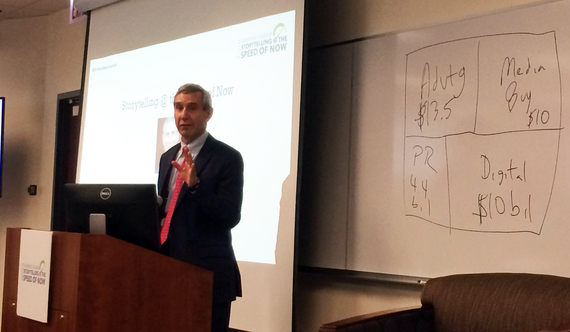Real-time media storytelling with "velocity" across a "proliferation of channels" is creating historic opportunities for the growing public relations industry to challenge the paid media turf of marketing and advertising. Richard Edelman, at Edelman PR's 2014 Academic Summit in Chicago, suggested, "PR is now poised to become a more prominent discipline in marketing services."
By the numbers, PR's top 10 agencies had $4.5 billion in revenue - four percent of the 2013 marketing pie, Ad Age reports. While, PR overall revenue growth of 2.4% was slightly larger than advertising agencies, both were relatively smaller than the 13.8% reported for digital.
Edelman's long view is to address the marketplace shift:
I am convinced that this is because the era of "marketing communications" - where classic, orchestrated advertising leads - is now in winter. It is giving way to an era of "communications marketing" - where spontaneous storytelling at the speed of now... is in full bloom.
If the "return to more substantive storytelling" that Edelman predicts is "social by design," then PR should be positioning itself to lead on the mobile earned and paid media front.
It stresses relevant, substantive storytelling, stakeholder engagement trust and, above all, shared value for customers, organizations and shareholders. It does not favor classic advertising or media buying.
PR professionals bring relationship building and reputation management to the party that marketing-based campaigns frequently miss.
Digital media, though, present unique and very specific brand practices that go beyond relationships. On Instagram, for example, Seen Founder and CEO Brian Zuercher says photographs with water or higher color saturation are "eye-catching" and improve engagement.
Zuercher says the perception of PR as "like a redheaded stepchild to marketing" is wrong because "PR firms have a much better opportunity to actually do relationship-building than an agency does" through great storytelling. Companies, such as Starbucks, cultivate a consumer expectation that the brand will respond, Zuercher said. "I think that's what PR firms are really great at doing, but now personalizing that and then delivering that in the right channel."
Given that most brand engagement is positive, Zuercher highlights the opportunities for consumer relationships: "If you can inspire them to create a moment that's very cool for them, that can go a long way."
It's clear that precision is needed within social media brand engagement, and the brand relationship is not the same as personal friendship on Twitter, Facebook, Instagram or other social sites.
Brand enthusiasts have knowledge and experience that may allow opinion leaders to answer questions, address brand issues and help crowd-source solutions. In this way, brand community managers can sit back, listen and engage only for clarification, much as a teacher might when students wander off course.
This kind of authentic engagement moves us beyond paid bloggers, questionable product reviews or forced conversation and toward solution-based social media engagement.
As lines that once separated PR from advertising and marketing are now viewed as "blurred," the challenge for professionals and academics is to retain core strengths, yet also learn to collaborate with digital media experts. In the end, better data measurement and analysis will be needed to refine compelling media storytelling.

